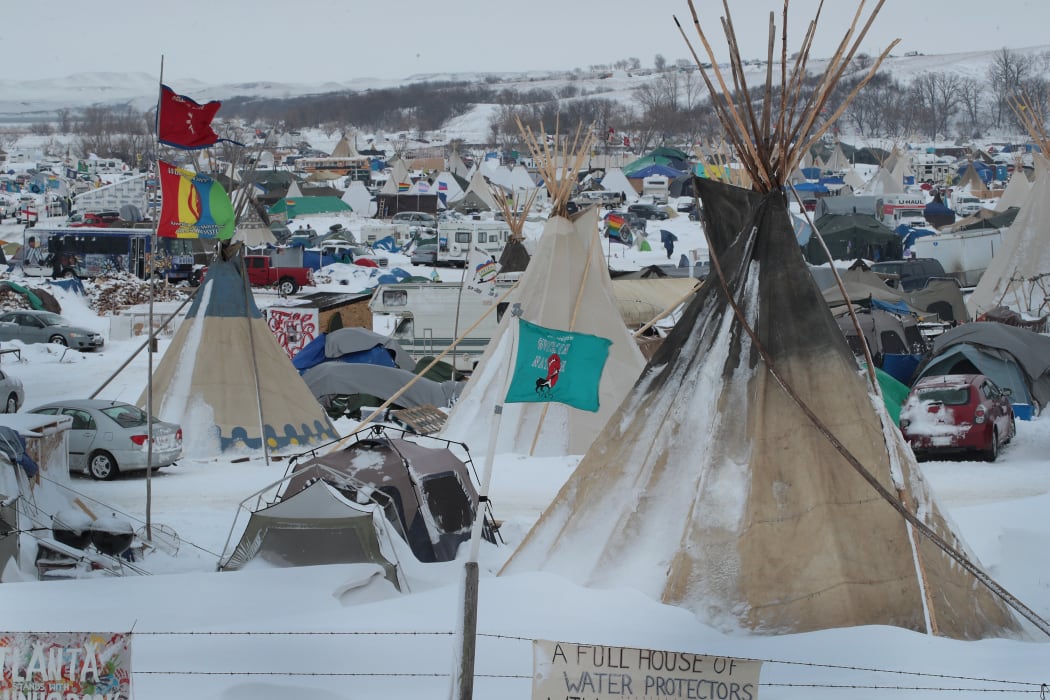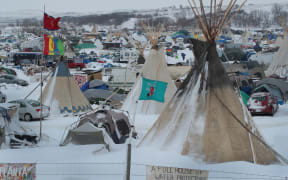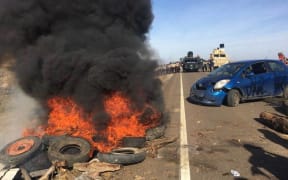In a victory for Standing Rock protesters, officials have denied a permit that would allow a controversial section of the Dakota Access Pipeline to be built.

Native Americans march to a burial ground sacred site that was disturbed by bulldozers building the Dakota Access Pipeline. Photo: AFP
The Standing Rock Sioux tribe, which has been protesting against the $US3.8 billion project, said in a statement the US Army Corps of Engineers had denied the project's owners an easement on the grounds it could contaminate water supplies.
The 1885km pipeline, owned by Texas-based Energy Transfer Partners LP, had been complete except for a segment planned to run under Lake Oahe, a reservoir formed by a dam on the Missouri River.
That stretch required an easement from federal authorities, which delayed a decision on the permit twice, in an effort to consult further with the tribe.
"Today, the US Army Corps of Engineers announced that it will not be granting the easement to cross Lake Oahe for the proposed Dakota Access Pipeline," the tribe's statement said.
"Instead, the Corps will be undertaking an environmental impact statement to look at possible alternative routes."
The US Army confirmed that in its own statement.
Standing Rock Chairman Dave Archambault II thanked activists for their support in the protest effort.
A celebration erupted at the main protest camp in Cannon Ball, North Dakota, where the Standing Rock Sioux tribe and others have been protesting for months.
"I hope they follow through here with this. They haven't been following the law all along. So we'll see - but this is a victory today for our people and our water," said Gerad Kipp, 44, an irrigation engineer from Montana and a Native American.
Protest organisers had for months argued that crossing the Missouri River adjacent to the Standing Rock Sioux Reservation presented a danger to their water source, as well as important cultural sites.
It is unclear what an alternative pipeline route would be, however.
Any route would probably need to cross the Missouri River, probably upstream of Lake Oahe and closer to the state capital of Bismarck.
North Dakota Senator Heidi Heitkamp nodded to the fact that the next steps remained unclear, saying in a statement that the pipeline "still remains in limbo".
It was also unclear whether the incoming Donald Trump administration may consider taking up Energy Transfer Partners' request yet again, and approving it. Mr Trump's transition team last week said that he was supportive of the line, in addition to other pipeline development.
New Zealanders have joined international support for the Native American protests through social media and online fundraising. Māori protesters travelled to Standing Rock to support the demonstrators.

Snow covers Oceti Sakowin Camp near the Standing Rock Sioux Reservation on November 30, outside Cannon Ball, North Dakota. Photo: AFP/ GETTY IMAGES NORTH AMERICA / Scott Olson
Police tactics against protesters defended
Protests against the pipeline have grown over the months, with hundreds of military veterans flocking to the camp in recent days to stand against what they said were aggressive tactics from law enforcement.
Police used water hoses and rubber bullets in a confrontation late last month.
State law enforcement officials have pointed out that most protesters are peaceful, but it only takes a few acting more aggressively to raise tensions.
Police have blocked Highway 1806 at Backwater Bridge, just north of the Oceti Sakowin camp, since 27 October, when protesters burned several vehicles on that structure. The bridge separates the camp from where Energy Transfer workers had been building the pipeline up to the edge of the river.
The 20 November confrontation, where about 400 protesters gathered, with some attempting to remove the charred vehicles from the bridge, saw police spray water and tear gas, despite freezing temperatures.
Police have released pictures of small propane devices they say protesters were trying to detonate on the bridge, in addition to hurling objects at police, including "burning logs, lug nuts from slingshots, from water bottles," he said.
Even as law enforcement defended previous tactics, they said they did not intend to confront protesters on the bridge unless they attempted to cross it or remove barricades.
More than 560 people have been arrested during the protests.
State officials last Monday ordered the thousands of protesters now present to leave the snowy camp, which is on US Army Corps of Engineers land, citing harsh weather.
Two days later they said they would not enforce the order. The temperature in the town of Cannon Ball is expected to fall to -16 Celsius next week.
- Reuters





